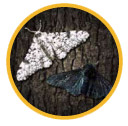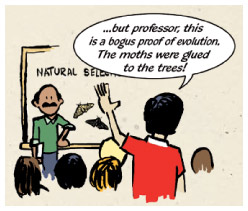 Students, do you like being misled? Consider a classic “centerpiece” of evolution that has been taught for 50 years. Textbooks show photos of light and dark colored moths camouflaged on light and dark tree trunks. Texts and many teachers then tell a convincing story about the moths being “proof” positive for Darwin’s idea of natural selection and resulting evolution. The story goes like this:
Students, do you like being misled? Consider a classic “centerpiece” of evolution that has been taught for 50 years. Textbooks show photos of light and dark colored moths camouflaged on light and dark tree trunks. Texts and many teachers then tell a convincing story about the moths being “proof” positive for Darwin’s idea of natural selection and resulting evolution. The story goes like this:
Before the industrial revolution in Great Britain, a large number of light-colored “peppered” moths existed alongside a smaller number of darker “peppered” moths. After the industrial revolution, the light colored bark of the trees became darkened. It was noticed that the peppered moth population also shifted to a predominance of darker moths. Why? The dark moths, being better camouflaged on the dark tree trunks, were not seen by birds and consequently not eaten. They survived, whereas most of the lighter moths perished since they were easily spotted. The conclusion? This is natural selection or “survival of the fittest” at its best, showing evolution in action.
Convincing? Yes! … True? Likely not! It certainly doesn’t “prove” evolution! Both varieties of moths were always present. There is no new “genetic stuff” – only color variations. The moths are still moths. It doesn’t explain how moths came to be in the first place or how “goo turned into you by way of the zoo” which involves going from no information to billions of encyclopedias worth of new genetic information.
Is it at least natural selection? Likely not! First of all, the moths may be smarter than we give them credit for. They may have exercised habitat selection since they “preferred” trees which afforded better camouflage. Second, and most important, the classic textbook photos showing the moths on tree trunks are bogus! The moths are nocturnal so are not “naturally selected” by birds in the daylight. Also, they don’t normally land on the tree trunks but usually under the foliage. According to Jonathan Wells in Icons of Evolution, one researcher said that in 25 years of his research, moths were observed to land on the trunk only twice! So where do textbooks get the photos to illustrate this “classic proof of natural selection”? Good question! Wells reports that the moths were placed, glued, and/or pinned to the bark of the tree, and then photographed!
“naturally selected” by birds in the daylight. Also, they don’t normally land on the tree trunks but usually under the foliage. According to Jonathan Wells in Icons of Evolution, one researcher said that in 25 years of his research, moths were observed to land on the trunk only twice! So where do textbooks get the photos to illustrate this “classic proof of natural selection”? Good question! Wells reports that the moths were placed, glued, and/or pinned to the bark of the tree, and then photographed!
Although some textbooks are quietly removing discussions of peppered moths, this classic textbook “proof” of evolution is still being taught even though it has been known to be wrong for 25 years! You can help get the word out. Please forward this link/article to as many others as possible!
Originally published in the September/October 2010 issue of Think & Believe newsletter.
Please call our office or email us at [email protected] for additional resources on these subjects.


